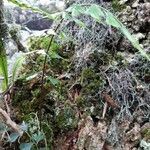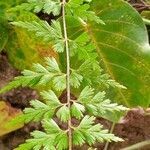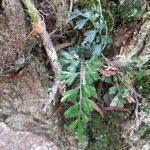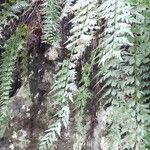Plants terrestrial or epilithic. Rhizome short-creeping, sparsely branched, to 150 mm long, to 5 mm in diameter, closely set with roots, persistent stipe bases and scales, scales chartaceous, atrocastaneous to ferrugineous, clathrate, sessile, subulate, cordate-imbricate, entire or shallowly dentate, smaller scales often with a few gland-like cells at the base, apex terminates in an oblong thin-walled cell, to 7 mm long, to 0.5 mm wide. Fronds closely spaced, arching, to 1.23 m long; stipe atrocastaneous, adaxially sulcate, to 625 mm long, to 3 mm in diameter, densely scaled initially, scales chartaceous, atrocastaneous to ferrugineous, clathrate, sessile, subulate to filiform, cordate-imbricate, entire or shallowly dentate, smaller scales often with a few gland-like cells at the base, apex terminates in an oblong thin-walled cell, to 6 mm long, to 0.5 mm wide; lamina anadromous, to 3-pinnate, narrowly elliptic to lanceolate, to 605 mm long, to 150 mm wide, with up to 22 petiolated pinna pairs; rachis firm, atrocastaneous, sulcate adaxially, initially closely set with scales similar to those on the stipe; pinnae petiolate, petiole to 6 mm long, opposite to alternate, basally more widely spaced, often slightly overlapping apically, firmly herbaceous, ovate to lanceolate, to 130 mm long, to 60 mm wide, with up to 6 petiolated pinnule pairs; pinna-rachis sulcate adaxially, sulcus confluent with that of the rachis, initially densely scaled, scales similar to, but smaller than, those on the rachis; pinnules petiolate, petiole to 2 mm long, alternate, spaced, 1-pinnate, trullate to narrowly trullate, to 33 mm long, to 22 mm wide, often with a single pair of petiolated segments; segments narrowly to broadly cuneate, trullate or obtrullate, divided into oblong segments, irregularly dentate, to 10 mm long, to 8 mm wide, adaxially sparsely scaled, scales chartaceous, ferrugineous, clathrate, sessile, filiform, cordate, entire, often with one or more gland-like cells near the base, apex terminates in an oblong thin-walled cell, to 0.3 mm long, abaxially initially moderately scaled, scales chartaceous, ferrugineous, clathrate, sessile, ovate, lanceolate, or filiform, usually with pluricellular filiform outgrowths and gland-like cells at the base, apex terminates in an oblong thin-walled cell, to 2 mm long, to 0.4 mm wide. Venation adaxially obscure, evident abaxially, flabellate, terminating in the teeth near the margin. Stomata (32-)40.04(-48) µm long. Sori linear, extending along a vein, to 5 mm long; indusium firmly herbaceous, stramineous, linear, entire, attached along the entire length, to 5 mm long, to 0.3 mm wide; sporangium long-stalked, simple, uniseriate, 3-seriate below the capsule, capsule globose in lateral view, with (18-)19(-20) indurated annulus cells, epistomium 2-celled, hypostomium 4(-5)-celled. Spores 64 per sporangium, brown, elliptic, monolete, with low reticulate ridges and prominent wings, (30-)34.03(-40) x (18-)20.91(-24) µm.
Plants 25-45 cm tall. Rhizome short, erect to shortly creeping, scaly; scales dark reddish brown to black, narrowly triangular with a long filiform apical tail. Fronds caespitose; stipe 5-15(-22) cm, adaxially grayish green and sulcate, abaxially dark brown to black, with many reddish to dark brown, narrowly triangular scales with a long filiform apex; lamina narrowly ovate to narrowly triangular, 10-28 × 4.5-8 cm, apex acuminate, pinnate-pinnatifid to 2-pinnate; pinnae 10-15 pairs, subopposite or alternate, lower 1 or 2 pairs slightly reduced, subsessile, trullate-rhomboid with 1 or 2 (almost) free pinnules at base, 2.5-4.5 × 1-2.5 cm, base asymmetrical, broadly cuneate, apex acuminate; pinnules 2-4 pairs, obtrullate-elliptic or subflabellate, 4-12 × 2-5 mm, margin dentate, lateral sides entire, apex obtuse. Venation subflabellate, obvious abaxially, veins slender and forked, not reaching margin, costa grooved adaxially. Fronds leathery, adaxially dark green when dry and often grooved, abaxially brownish green, with reddish brown, fibrillose scales, subglabrous when old; rachis green but often becoming dark toward base abaxially, adaxially sulcate and densely scaly with fibrillose scales. Sori 2-5 per segment, linear, 3-8 mm, median on subtending veins; indusia grayish yellow, linear, membranous, entire, opening toward major veins or to costa, persistent. Plants polyploid, sexual or agamosporous.
Lithophytic or rarely epiphytic fern with semi-erect or pendent fronds. Rhizome short-creeping, scaly. Stipe and rachis almost black at base, becoming green towards apex, shiny, abundantly scaly; stipe 3–25 cm long, 0.5–2 mm diam. Lamina 2-or 3-pinnate at base, elliptic or ovate to narrowly elliptic, 4.5–25 cm long, 2–12 cm wide, dark green above, paler below, sparsely scaly. Primary pinnae in 5–15 pairs, ovate to narrowly ovate; apices acuminate; longest pinnae at or below middle, 1.4–7 cm long, 0.6–3.5 cm wide. Secondary pinnae linear or narrowly obovate; margins entire; apices acute or obtuse and deeply incised; bases narrowly cuneate, sessile or shortly-stalked; longest pinnae 5–35 mm long, 1–15 mm wide; secondary pinnae on the largest fronds divided again into ultimate segments up to 10 mm long and 2 mm wide. Sori to 8 mm long. Perispores pale with smooth broad ridges and smooth lacunae; exospores 44.2–56.4 × 27.7–33.7 µm (means).
Rhizome ascending or creeping, up to 7 mm in diameter, set with linear-attenuate, ferrugineous to atrocastaneous, hair-pointed, irregularly serrulate rhizome-scales often with paler reddish margins. Fronds tufted, firmly herbaceous to thinly coriaceous, not gemmiferous; stipe matt brown to atrocastaneous, set with scattered scales; lamina oblong to lanceolate, attenuate, up to 480 x 200 m (rarely 750 x 400 m), 2-pinnate to 4-pinnatifid, lower pinnae only slightly reduced; pinnae in c. 12 pairs, acute to caudate, divided into narrowly obcuneate to very narrowly oblong segments, upper segments adnate and decurrent, irregularly incised and dentate, upper surface often set with occasional substellate or fimbriate scales, lower surface thickly to thinly set with hair-pointed, broad-based scales. Sori of irregular lengths, up to 9 mm long; indusium membranous, subentire, c. 0.4 mm broad.
Terrestrial, epilithic or low-level epiphyte. Rhizome creeping, prostrate to suberect, with light brown to dark brown or blackish scales. Fronds tufted, arching, variable, deeply 2-pinnatifid to 3-pinnate, lamina ovate to very narrowly lanceolate, 60-250 x 35-140 mm, basal pinnae usually reduced, subglabrous adaxially, abaxial surface sparsely set with small twisted scales; pinnae ovate to narrowly lanceolate, apex sharply acute to acuminate, margins irregularly serrate; rachis and stipe dark brown, densely covered with hair-like scales, becoming subglabrous with age. Sporangia in linear, indusiate sori borne closely packed along veins.
Rhizome short-decumbent, up to 7 mm in diam., with ferruginous to dark brown, linear-attenuate, hair-pointed scales, up to 9 x 1.6 mm. Fronds caespitose, up to 700 mm long. Stipe brown, up to 100 mm long, up to 2 mm in diam., variously scaled. Lamina firmly herbaceous to thinly coriaceous, oblong to lanceolate-attenuate, up to 480 x 200 mm, 2-pinnate to 4-pinnatifid, with up to 12 pinna pairs. Pinnae divided into narrowly obovate to narrowly oblong segments, irregularly incised, subglabrous adaxially, variously scaled abaxially. Sori linear, of irregular lengths, up to 9 mm long. Indusium subentire, membranous, up to 0.4 mm wide.
Perennial with short rhizome. Fronds arching, to 35 cm, stipe scaled, lamina firmly herbaceous, lanceolate, 2-pinnate to 4-pinnatifid, pinnae divided into narrowly obovate to narrowly oblong segments, irregularly incised, subglabrous above, scaled beneath. Sori linear, of irregular lengths, indusium subentire.
Rhizome ascending or creeping, set with ferrugineous to atrocastaneous rhizome scales. Fronds tufted, set with numerous scales, with long hair points. Pinnae deeply pinnatifid into more than 5 lobes, acute to caudate. Sori of irregular lengths, up to 9 mm long.




